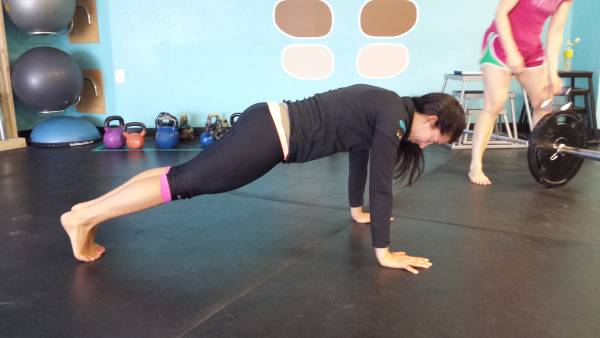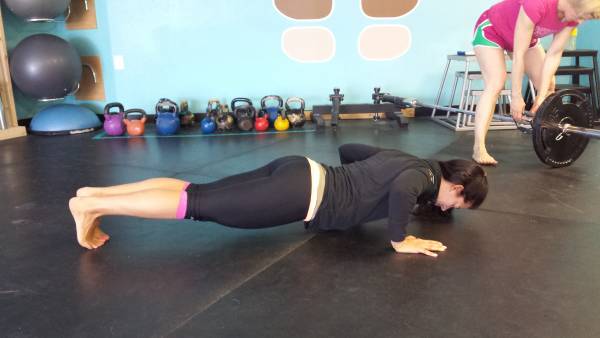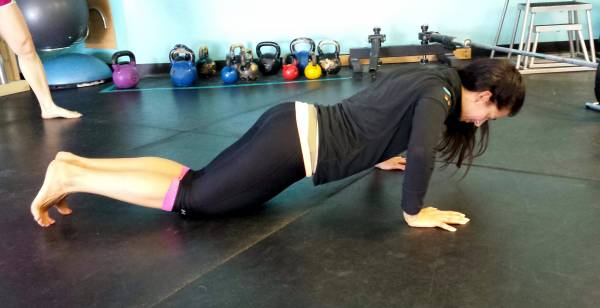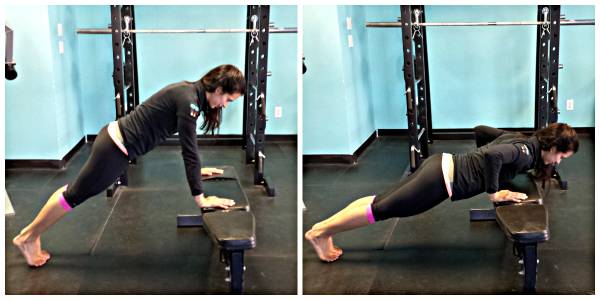The push-up is one of the greatest exercises you can do. It is a full-body movement that can be done anywhere. That said, the push-up can be a difficult movement to master for some people, often requiring modifications at first.
This article is going to be fairly short, sweet, and to the point. But I’m going to ask one big favor of those of you who currently lack the strength to do a full push-up: Stop doing the modified push-up where your knees are on the floor.
Related: The Best Chest Workouts for Muscle Mass, Strength, and More
It’s actually quite simple: if you do push-ups with your knees on the floor, you will get better at one thing and one thing only – doing push-ups with your knees on the floor. Sorry to burst your bubble, but by doing this modification you are not ever going to get better at doing full push-ups. You just won’t.
“[I]f you do push-ups with your knees on the floor, you will get better at one thing and one thing only – doing push-ups with your knees on the floor.”
Why? Because you are neither training the proper movement, nor using or training many of the muscles involved in the push-up. Let’s break this down, first by looking at the push-up position.
The Proper Push-Up Position
In the proper push-up position, the feet are together, glutes are squeezed, and the back is in a neutral position. In other words, there should be no sag in the back and everything should be tight.

In a full push up, the entire body is working together throughout the entire movement.
Then, the entire body should move in straight line, with no sag and with your elbows at approximately a 45-degree angle. At the bottom of the movement, your forearms should be vertical to the ground.

Done correctly, a push up is really just a moving plank.
As you can see in this description, the entire body is working together, in sync, throughout the entire movement. The core and glutes are stabilizing the lumbar spine, the back is engaged, and the chest is set up in an optimal position for work. If you think about it, you can see this is really just a moving plank.
Push Ups On the Knees
Now, let’s compare this to a push up with your knees on the floor. In this position, you are taking your legs out of the equation entirely. It becomes more difficult to engage your glutes (just try to squeeze your glutes in this position – it isn’t as easy). You also don’t need to stabilize your lumbar spine as much, and you couldn’t anyway as you are effectively turning off the stabilizers of the hip (which play a huge role in lumbar spine stabilization).
“In this position, you are taking your legs out of the equation entirely. It becomes more difficult to engage your glutes (just try to squeeze your glutes in this position – it isn’t as easy).”
Even more, when you then start to lower to the bottom of the push up, the on-the-knees position causes most people to lead the movement with their elbows. This means they are rarely able to end the position with the forearms vertical to the floor. This puts unnecessary stress on the elbow, wrist, and shoulder, which could potentially lead to injuries, not to mention it isn’t the optimal position for strengthening the chest muscles.

Knee push ups also put unnecessary stress on the elbow, wrist, and shoulder.
What’s Really Stopping You?
These reasons for not doing knee push ups may not seem like a big deal, but they are. For many people the reason they struggle with push ups isn’t necessarily their upper body strength. Of course, it’s part of the struggle, but what is often a bigger limitation is that people lack the core strength and/or the proper movement patterning to execute this movement correctly. This is why performing this movement on your knees will in no way help you improve your full push up and will potentially cause you more harm than good in the long run.
What If You Can’t Do a Full Push Up?
If you can’t do a full push up, don’t do more push ups from your knees expecting to get better. Instead, modify the full push up position so your body learns to properly stabilize and work together.
“Remember, your core is your pillar. It is where all of your strength and power comes from. If you don’t have a strong pillar, you can’t expect to efficiently and effectively move your limbs.”
How do you do that? The incline push up. Use a bench, Smith machine (pretty much the only thing they are good for), or barbell on a rack and elevate your hands to the point where you can perform the full movement while maintaining a neutral back and strong core. As you improve, you can lower the position of the bar until you eventually are back to the floor.

Incline push ups allow you to maintain a neutral back and strong core.
Your Core Is Your Pillar
I know this information might be completely surprising to you reading this. Don’t worry about how you’ve done push ups on your knees in the past, and instead look to improving them from this point on.
Remember, your core is your pillar. It is where all of your strength and power comes from. If you don’t have a strong pillar, you can’t expect to efficiently and effectively move your limbs. This is why performing the push up in any way other than a plank position is not going to help you improve your push ups.
Further Reading:






